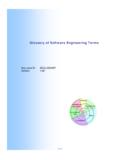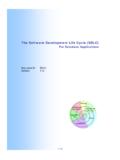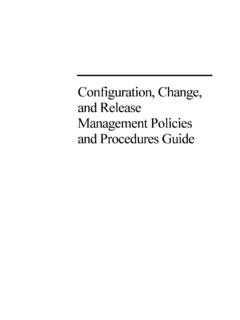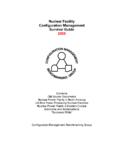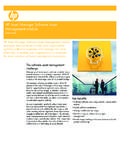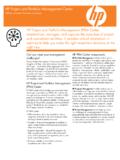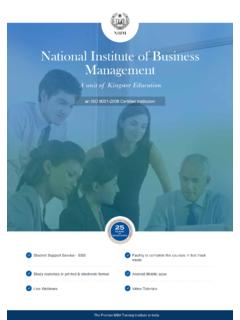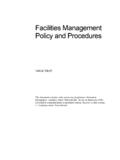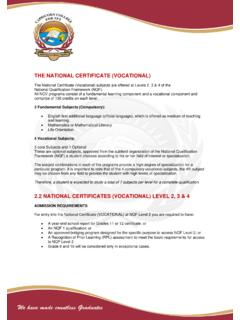Transcription of Software Configuration Management Plan - Shell …
1 Software Configuration Management plan For Database Applications Document ID: SCMP Version: PlanningRequirements DefinitionDesignDevelopmentIntegration & TestInstallation & Acceptance 1 / 22 Software Configuration Management plan SCMP For Database Applications Version Copyright 2000-2005 Digital Publications LLC. All Rights Reserved. 2 Software Configuration Management plan SCMP For Database Applications Version TABLE OF CONTENTS 4 PURPOSE & 4 5 7 8 EVOLVING 8 SOURCE 8 SUPPORT 9 ARCHIVE 9 9 11 EVOLVING ITEM 11 SOURCE ITEM 13 SUPPORT ITEM 13 ARCHIVE ITEM 13 14 EVOLVING 14 SOURCE 14 SUPPORT 14 ARCHIVE 15 CHANGE CONTROL 16 EXTERNALLY-IDENTIFIED 17 17 17 REVISION Management 20 21 IN-STAGE 21 3 Software Configuration Management plan SCMP For Database Applications Version INTRODUCTION This document represents the Software Configuration Management plan for database applications development.
2 Configuration Management (CM) is essentially the process of identifying and assuring retention and control of all of the various artifacts (documents, source code, executables, e-mail, etc.) generated during the Software Development Life Cycle (SDLC). PURPOSE & SCOPE The primary objective of the CM process is to establish and manage baselines of product releases. CM for Software engineering is defined as: A set of requirements, design, source code files and the associated executable code, build files, and user documentation (associated entities) that have been assigned a unique identifier can be considered to be a baseline. Release of a baseline constitutes retrieval of source code files ( Configuration items) from the Configuration Management system and generating the executable files. A baseline that is delivered to a customer is typically called a release whereas a baseline for an internal use is typically called a build.
3 1 This CM process is tailored to fit database-oriented Software development efforts, and is related to the planning and life cycle description documents for the project. This plan provides the criteria and direction necessary for the performance of the CM process during the SDLC and pertains to the products either produced as a result of the development effort or procured as support or reference items. 1 Chrissis, M. B., Konrad, M., & Shrum, S. (2003). CMMI: Guidelines for Process Integration and Product Improvement ( ). Boston, MA: Pearson Education, Inc. 4 Software Configuration Management plan SCMP For Database Applications Version METHODOLOGY The methodology presented here is based on the Software Engineering Institute s (SEI) Capability Maturity Model, Integrated (CMMI) and the Institute for Electrical and Electronics Engineers (IEEE) standards for Information Management .
4 This SCM plan : Makes use of the principal project participants as defined in the Vision & Scope chapter of the project planning document. Describes the various categories of project artifacts, and how each category is to be controlled. Describes how the various project artifacts will be identified, and how that identification will change as each artifact evolves. Describes processes for approving and controlling revisions, assuring the availability of the most recent version of each artifact to all project participants, and making previous versions available upon request. Configuration ITEMS Project artifacts that are uniquely identified and placed under version control are known as Configuration Items. Configuration items fall into four general classes: 1. Evolving items, such as documents, which are subject to one or more revisions and new releases during the SDLC.
5 2. Source items, generally source code and object files used to build a production Software application, which are generally numerous and frequently changing. 3. Support items, such as operating systems, of which the project requires certain versions for successful operation. 4. Archive items, such as SQA review forms which generally support decisions made during the SDLC are stored in electronic format for future reference. PERSONNEL ROLES AND RESPONSIBILITIES In a database development effort, two principal roles are defined for SCM activities: 1. Primary End-user Representative (PER) 2. Primary Developer Representative (PDR) The PER acts as the primary point of contact for the end-user community. The PER is responsible for ensuring that significant project-related documents and communications generated by the end-user community are relayed to the PDR for storage and future reference.
6 5 Software Configuration Management plan SCMP For Database Applications Version The PDR acts as the primary point of contact for the development team. The PDR is responsible for the identification, control, and distribution of project Configuration items. The PDR also maintains a central repository of issues, recording new issues raised by project participants and end users. Configuration CONTROL BOARD (CCB) The project Executive Sponsor, the PER, and the PDR (at a minimum) comprise the CCB (also known as a Change Control Board) for a specific project. The project SPMP describes any additional personnel assigned to the CCB. The CCB is responsible for prioritizing and selecting issues to be resolved during each iteration of the SDLC. The purpose of the CCB in the context of Software development and maintenance is to prioritize and select issues to be addressed during a specific SDLC iteration.
7 The CCB is also responsible for determining the timing of support item hardware and Software upgrades. Since these upgrades often impact production Software viability, the CCB controls the revision cycle for these items. Configuration Management PROCESSES The processes used to manage Configuration items fall into five main categories: 1. Classification: Each project artifact is classified as a member of one of the four Configuration item classes. 2. Identification: Configuration items are assigned appropriate identifiers. 3. Storage: Configuration items are stored via mechanisms appropriate to their classes. 4. Change Control: Configuration items are modified in response to approved issues (enhancement requests or defect reports). 5. Revision Management : Each Configuration item is revised in a manner appropriate to its class; archive items are never revised.
8 Separate chapters following this introduction address each of these processes. 6 Software Configuration Management plan SCMP For Database Applications Version METRICS The PDR is responsible for tracking metrics associated with CM activities. The metrics to be captured are defined in the project SPMP. REFERENCES The Software development lifecycle for this project defines a series of stages; each project stage is defined as a separate operation with specific inputs and outputs. This SCM plan describes how these inputs and outputs will be controlled and managed. The complete Software development lifecycle for this project is described in a separate document, available at: Please refer to the SDLC document for a description of the structure, inputs to and outputs from each of the stages of the SDLC, as well as a comparison to other SDLC models.
9 Other terms common to the Software development process are defined in a Glossary of Software Engineering Terms, available at: Please refer to this glossary for definitions of the terms used in this document and in the SDLC document. STANDARDS The following standards were used as guides to develop this CM process. The standards were reviewed and tailored to fit the specific requirements of database projects using the referenced SDLC. ANSI/IEEE 828-1990: Standard for Software Configuration Management Plans SEI/CMMI: Configuration Management Process Area 7 Software Configuration Management plan SCMP For Database Applications Version CLASSIFICATION Project artifacts such as documents, applications, and support/reference files generated or purchased during the SDLC are all referred to as Configuration items.
10 As each item is generated or purchased, it must first be classified into one of four Configuration item classes: Evolving, Source, Support or Archive. EVOLVING ITEMS Evolving items generally take the form of documents, help files, test data and application executables generated during the development process. These items are generally revised one or more times during the SDLC, and as such are considered to be evolving. Evolving items are usually project stage deliverables, and are generated as a result of collaboration between participants. Although evolving items are in the substantial minority of all items generated or purchased during the SDLC, they require the most control and coordination, and are the subject of the majority of the processes described in this plan . In some cases, the CM tool used for Management of evolving items is the same as that used for source items (described below).
